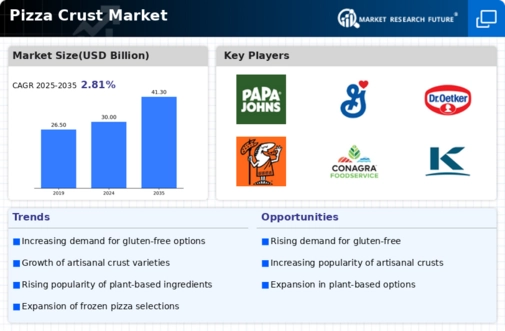Market Growth Projections
The Global Pizza Crust Market Industry is projected to experience steady growth, with significant financial metrics indicating its potential. In 2024, the market is expected to reach 30.0 USD Billion, with a forecasted increase to 41.3 USD Billion by 2035. This growth trajectory suggests a compound annual growth rate of 2.95% from 2025 to 2035. Such projections reflect the increasing consumer preference for pizza as a versatile meal option, coupled with ongoing innovations in crust offerings. The market's resilience and adaptability to changing consumer demands are likely to play a pivotal role in achieving these growth targets.
Health and Wellness Trends
The Global Pizza Crust Market Industry is significantly influenced by the rising health consciousness among consumers. There is a growing inclination towards healthier eating habits, prompting manufacturers to develop crusts made from whole grains, gluten-free ingredients, and organic components. This shift aligns with the broader trend of seeking nutritious alternatives in food choices. As consumers become more aware of the nutritional content of their meals, the demand for healthier pizza crust options is likely to increase. This trend not only caters to health-conscious individuals but also appeals to those with dietary restrictions, thereby expanding the market's reach.
Expansion of Foodservice Channels
The Global Pizza Crust Market Industry benefits from the expansion of foodservice channels, including restaurants, cafes, and delivery services. As dining out becomes increasingly popular, the demand for high-quality pizza crusts rises correspondingly. Foodservice establishments are seeking to differentiate themselves by offering unique and premium crust options, which can enhance the overall dining experience. This trend is expected to contribute to the market's growth, with projections indicating a rise to 41.3 USD Billion by 2035. The collaboration between crust manufacturers and foodservice providers fosters innovation and quality improvements, further solidifying the market's position.
Emerging Markets and Globalization
The Global Pizza Crust Market Industry is poised for growth due to the globalization of food culture and the emergence of new markets. As pizza becomes a staple in various regions, particularly in developing countries, the demand for diverse crust options increases. This trend is fueled by the influence of Western dining habits and the growing popularity of international cuisine. Manufacturers are adapting their offerings to cater to local tastes and preferences, thereby expanding their market reach. The anticipated compound annual growth rate of 2.95% from 2025 to 2035 underscores the potential for sustained growth in these emerging markets.
Rising Demand for Convenience Foods
The Global Pizza Crust Market Industry experiences a notable surge in demand for convenience foods, driven by the fast-paced lifestyle of consumers. As individuals increasingly seek quick meal solutions, the appeal of ready-to-bake or pre-made pizza crusts becomes evident. In 2024, the market is projected to reach 30.0 USD Billion, reflecting a growing preference for products that save time in meal preparation. This trend is particularly pronounced among busy families and young professionals who prioritize convenience without compromising on taste. Consequently, manufacturers are innovating to offer a diverse range of crust options that cater to these evolving consumer preferences.
Innovation in Flavors and Ingredients
Innovation plays a crucial role in the Global Pizza Crust Market Industry, as manufacturers continuously explore new flavors and ingredients to attract diverse consumer segments. The introduction of unique crust flavors, such as garlic, herb-infused, or even spicy variants, enhances the overall pizza experience. Additionally, the incorporation of alternative ingredients, such as cauliflower or chickpea flour, caters to the growing demand for gluten-free and low-carb options. This innovation not only satisfies consumer curiosity but also aligns with dietary trends, potentially driving market growth. As the industry evolves, the emphasis on flavor and ingredient diversity is likely to remain a key driver.
























Leave a Comment